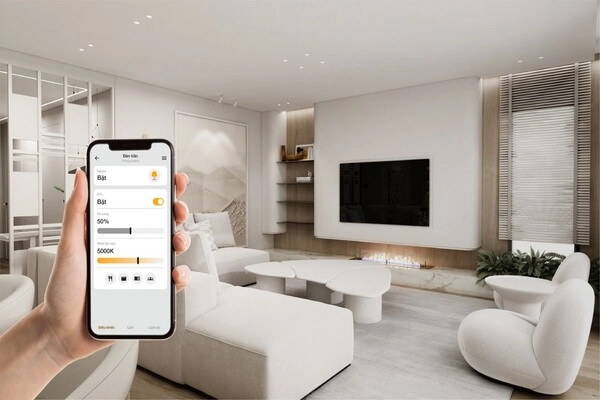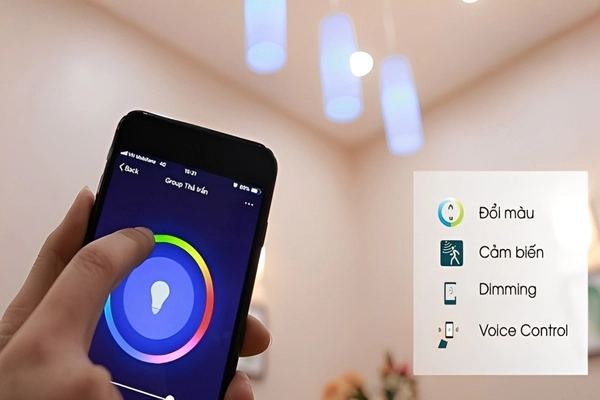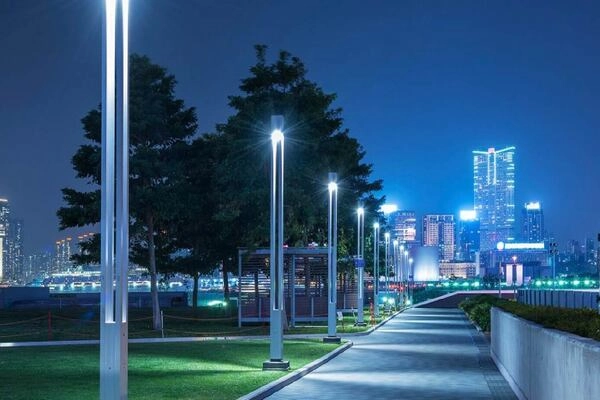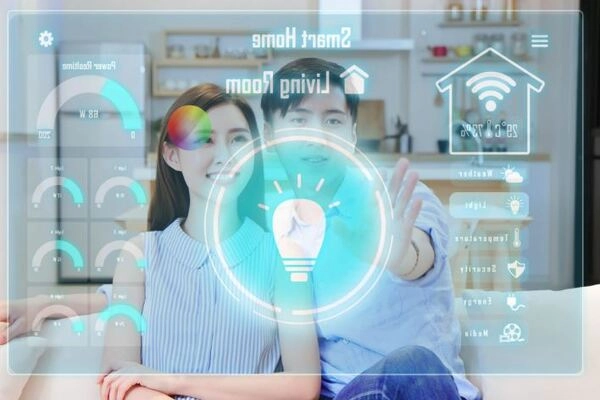IoT lighting systems are becoming an essential trend in the era of smart cities and digital transformation. Thanks to connectivity, automation, and energy optimization, these systems enhance lighting efficiency, reduce operational costs, and improve safety across various environments such as streets, factories, office buildings, and residential areas. The development of AI and emerging IoT standards further promotes smart lighting as a sustainable and modern solution for the future.
What is an IoT Lighting System?
An IoT lighting system is a smart lighting model that leverages the Internet of Things (IoT) to connect lighting devices into a centralized control network. Unlike traditional systems that rely on manual on-off operation, IoT lighting allows real-time data collection, automatic brightness adjustment, remote device monitoring, and optimization of energy consumption.

All lights, light sensors, motion detectors, controllers, and management platforms work together seamlessly to provide a flexible, safe, and efficient lighting solution. With smart connectivity and automation capabilities, this system is becoming a key trend in smart cities, factories, office buildings, and modern residential areas.
Benefits of IoT Lighting Systems
Implementing IoT lighting systems offers clear advantages for households, businesses, urban areas, and industrial zones. The following sections highlight the most notable benefits that this solution can provide.

Energy and Cost Savings
One of the major advantages of IoT lighting systems is their exceptional energy-saving capability. Equipped with light sensors, motion detectors, and automatic brightness adjustment algorithms, the system operates only when needed. Optimizing on/off schedules, dimming levels, or turning off lights in unused areas can significantly reduce electricity bills, especially in factories, offices, and large buildings.
Easy Remote Management and Monitoring
With an IoT lighting system, users can control all devices remotely via smartphones, tablets, or dedicated software. This allows managers to monitor light status in real time, identify active or problematic areas, and respond promptly. Centralized management saves time and labor while ensuring consistent lighting performance.
Enhanced Safety and Lighting Efficiency
IoT lighting systems can automatically adjust brightness according to the environment, ensuring optimal illumination at all times. This reduces workplace accidents, enhances outdoor security, and creates a comfortable experience for users. The system also sends alerts when a light is malfunctioning or nearing the end of its life, enabling timely maintenance and avoiding operational disruptions.
Popular IoT Smart Lighting Solutions
Today, IoT lighting solutions are diverse, meeting the varied needs of different environments. From individual light control to area-based automation, these solutions are widely implemented and deliver high efficiency.

Individual Light Control via IoT
This solution allows each light to be controlled independently, including turning on/off, adjusting brightness, or checking status. It is ideal for spaces requiring detailed control, such as laboratories, small offices, or display areas. Individual control helps save energy and increases flexibility.
Cluster-Based Lighting Control
Instead of managing each light separately, the system can divide lights into clusters for synchronized control. This approach is suitable for factories, public areas, or large buildings with a high number of lights. Cluster control reduces system load, speeds up response times, and is ideal for areas with shared lighting purposes.
Automatic Demand-Based Dimming
Automatic dimming is a key feature that optimizes lighting according to environmental conditions. Light sensors adjust brightness based on ambient light or movement within the area. This ensures spaces are adequately illuminated without wasting energy, extends the lifespan of the lights, and reduces operational costs.
Practical Applications of IoT Lighting Systems
Today, IoT lighting systems are widely applied due to their ability to optimize energy use, enhance safety, and reduce operating costs. Each environment has specific lighting requirements, and IoT systems can meet these needs precisely. Two of the most common and prominent applications in modern life include:
Smart Street Lighting
Smart street lighting is one of the most powerful applications of IoT lighting systems. Street lights are equipped with motion sensors, light sensors, connectivity modules, and remote controllers. This allows the lights to automatically adjust according to traffic flow, time of day, or weather conditions.

When the streets are empty, the system dims the lights to save energy; when vehicles or pedestrians are present, the lights automatically brighten to ensure safety. Urban control centers can monitor the status of each lamp post, detect faulty bulbs, check energy consumption, and schedule maintenance efficiently. This not only reduces costs but also helps lower carbon emissions and improves overall urban management quality.
Lighting in Factories, Buildings, and Residential Areas
In industrial and residential environments, IoT lighting systems play a crucial role in optimizing space and enhancing productivity. Office buildings can use presence sensors to turn lights on when areas are occupied and off when empty. The system can also adjust brightness based on natural light entering the space, creating a comfortable working environment, reducing visual fatigue, and saving energy.

In factories, IoT lighting ensures optimal illumination for each production line and provides alerts when equipment encounters issues. In residential areas, the system enhances security with automatic evening lighting, mobile control, or integration with other smart alert systems. Altogether, it delivers a safer, more modern, and convenient living experience.
Comparing IoT Lighting Systems and Traditional Lighting
To fully understand the value of IoT lighting, a direct comparison with traditional lighting highlights the differences in features, energy efficiency, and operational capabilities.
| Criteria | IoT Lighting System | Traditional Lighting System |
| Automation | Real-time adjustment with smart sensors | Mostly manual control, minimal automation |
| Energy Savings | High, thanks to sensors and optimized control | Low, continuous operation leads to waste |
| Remote Management | Controlled via app from anywhere | No remote management support |
| Safety | Early alerts for overloads, faults, fire risks | Hard to detect issues, relies on manual checks |
| Data Collection & Analysis | Available for monitoring consumption and optimizing operation | No data collection capability |
| Initial Cost | High due to IoT devices and platforms | Low, simple installation |
| Dependence on Internet | Yes, weak network may disrupt operation | No internet required |
| Infrastructure Requirements | Requires standardized, synchronized system | Low infrastructure requirement, easy deployment |
| Security | Risk of data leakage if security is weak | Minimal data-related risk |
IoT lighting provides automation, energy savings, enhanced safety, and intelligent management, while traditional systems are simpler and lower cost but limited in efficiency and flexibility.
Challenges and the Future of IoT Lighting Systems
Despite its great potential, IoT lighting faces challenges related to security, scalability, and standardization. Nevertheless, the smart lighting market is expected to grow rapidly. The following three factors will largely determine the future development of IoT lighting systems.

Security and Data Privacy
Since IoT lighting systems are continuously connected to the Internet, data security becomes a top priority. Hackers can gain unauthorized access, disrupt operations, or steal information. Therefore, strong encryption, multi-layer authentication, and strict access control are essential. Developers also need to regularly update firmware to address vulnerabilities and ensure the system operates safely at all times.
System Integration and Scalability
IoT lighting systems must be capable of integrating with other devices and platforms such as security systems, HVAC, building management systems (BMS), or Smart City platforms. However, the diversity of communication standards and devices from multiple vendors makes integration challenging. In the future, universal connectivity standards like Zigbee, BLE, or Matter will enhance scalability, ensuring stable and synchronized system performance.
Future Trends in Smart Lighting
The development of smart lighting is guided by several key trends:
- AI and Machine Learning: Analyze data to predict lighting needs and create optimal lighting scenarios.
- Renewable Energy Integration: Combine with solar power to reduce electricity costs and increase sustainability.
- Personalized Lighting: Adjust lighting according to circadian rhythms to boost productivity and improve health.
- IoT Device Standardization: Simplify deployment, reduce costs, and improve cross-brand compatibility.
These trends will make IoT lighting systems increasingly intelligent, energy-efficient, and environmentally friendly.
IoT lighting is becoming a critical solution for energy management and smart illumination in cities, businesses, and residential areas. With automation, cost savings, and enhanced safety, the technology is being widely adopted. Despite challenges in security and infrastructure, the advancement of AI, connectivity standards, and renewable energy will continue to drive IoT lighting forward, laying the foundation for modern and sustainable living environments.
